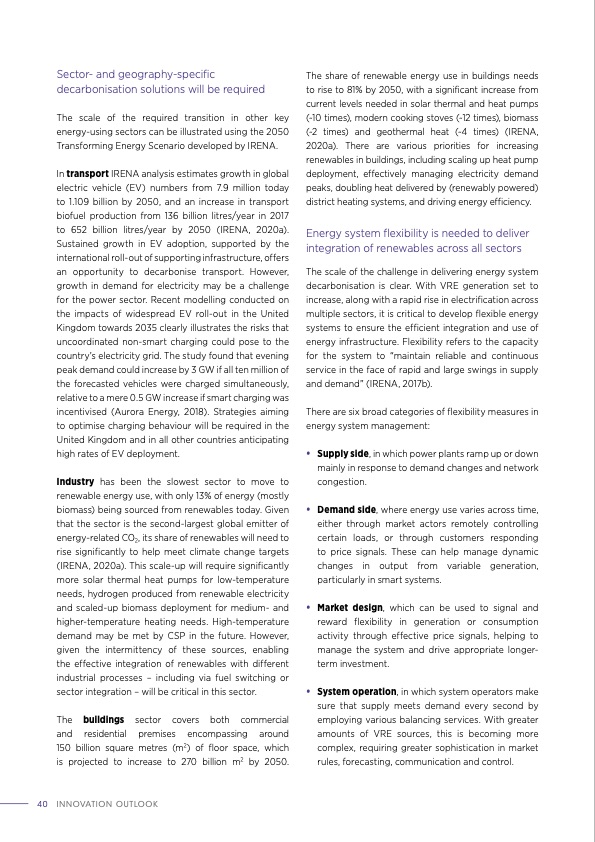
PDF Publication Title:
Text from PDF Page: 040
Sector- and geography-specific decarbonisation solutions will be required The scale of the required transition in other key energy-using sectors can be illustrated using the 2050 Transforming Energy Scenario developed by IRENA. In transport IRENA analysis estimates growth in global electric vehicle (EV) numbers from 7.9 million today to 1.109 billion by 2050, and an increase in transport biofuel production from 136 billion litres/year in 2017 to 652 billion litres/year by 2050 (IRENA, 2020a). Sustained growth in EV adoption, supported by the international roll-out of supporting infrastructure, offers an opportunity to decarbonise transport. However, growth in demand for electricity may be a challenge for the power sector. Recent modelling conducted on the impacts of widespread EV roll-out in the United Kingdom towards 2035 clearly illustrates the risks that uncoordinated non-smart charging could pose to the country’s electricity grid. The study found that evening peak demand could increase by 3 GW if all ten million of the forecasted vehicles were charged simultaneously, relative to a mere 0.5 GW increase if smart charging was incentivised (Aurora Energy, 2018). Strategies aiming to optimise charging behaviour will be required in the United Kingdom and in all other countries anticipating high rates of EV deployment. Industry has been the slowest sector to move to renewable energy use, with only 13% of energy (mostly biomass) being sourced from renewables today. Given that the sector is the second-largest global emitter of energy-related CO2, its share of renewables will need to rise significantly to help meet climate change targets (IRENA, 2020a). This scale-up will require significantly more solar thermal heat pumps for low-temperature needs, hydrogen produced from renewable electricity and scaled-up biomass deployment for medium- and higher-temperature heating needs. High-temperature demand may be met by CSP in the future. However, given the intermittency of these sources, enabling the effective integration of renewables with different industrial processes – including via fuel switching or sector integration – will be critical in this sector. The buildings sector covers both commercial and residential premises encompassing around 150 billion square metres (m2) of floor space, which is projected to increase to 270 billion m2 by 2050. The share of renewable energy use in buildings needs to rise to 81% by 2050, with a significant increase from current levels needed in solar thermal and heat pumps (~10 times), modern cooking stoves (~12 times), biomass (~2 times) and geothermal heat (~4 times) (IRENA, 2020a). There are various priorities for increasing renewables in buildings, including scaling up heat pump deployment, effectively managing electricity demand peaks, doubling heat delivered by (renewably powered) district heating systems, and driving energy efficiency. Energy system flexibility is needed to deliver integration of renewables across all sectors The scale of the challenge in delivering energy system decarbonisation is clear. With VRE generation set to increase, along with a rapid rise in electrification across multiple sectors, it is critical to develop flexible energy systems to ensure the efficient integration and use of energy infrastructure. Flexibility refers to the capacity for the system to “maintain reliable and continuous service in the face of rapid and large swings in supply and demand” (IRENA, 2017b). There are six broad categories of flexibility measures in energy system management: • Supply side, in which power plants ramp up or down mainly in response to demand changes and network congestion. • Demand side, where energy use varies across time, either through market actors remotely controlling certain loads, or through customers responding to price signals. These can help manage dynamic changes in output from variable generation, particularly in smart systems. • Market design, which can be used to signal and reward flexibility in generation or consumption activity through effective price signals, helping to manage the system and drive appropriate longer- term investment. • System operation, in which system operators make sure that supply meets demand every second by employing various balancing services. With greater amounts of VRE sources, this is becoming more complex, requiring greater sophistication in market rules, forecasting, communication and control. 40 INNOVATION OUTLOOKPDF Image | THERMAL ENERGY STORAGE Outlook

PDF Search Title:
THERMAL ENERGY STORAGE OutlookOriginal File Name Searched:
IRENA_Innovation_Outlook_TES_2020.pdfDIY PDF Search: Google It | Yahoo | Bing
Turbine and System Plans CAD CAM: Special for this month, any plans are $10,000 for complete Cad/Cam blueprints. License is for one build. Try before you buy a production license. More Info
Waste Heat Power Technology: Organic Rankine Cycle uses waste heat to make electricity, shaft horsepower and cooling. More Info
All Turbine and System Products: Infinity Turbine ORD systems, turbine generator sets, build plans and more to use your waste heat from 30C to 100C. More Info
CO2 Phase Change Demonstrator: CO2 goes supercritical at 30 C. This is a experimental platform which you can use to demonstrate phase change with low heat. Includes integration area for small CO2 turbine, static generator, and more. This can also be used for a GTL Gas to Liquids experimental platform. More Info
Introducing the Infinity Turbine Products Infinity Turbine develops and builds systems for making power from waste heat. It also is working on innovative strategies for storing, making, and deploying energy. More Info
Need Strategy? Use our Consulting and analyst services Infinity Turbine LLC is pleased to announce its consulting and analyst services. We have worked in the renewable energy industry as a researcher, developing sales and markets, along with may inventions and innovations. More Info
Made in USA with Global Energy Millennial Web Engine These pages were made with the Global Energy Web PDF Engine using Filemaker (Claris) software.
Sand Battery Sand and Paraffin for TES Thermo Energy Storage More Info
| CONTACT TEL: 608-238-6001 Email: greg@infinityturbine.com | RSS | AMP |